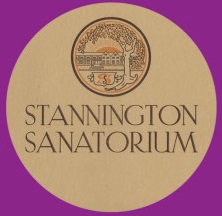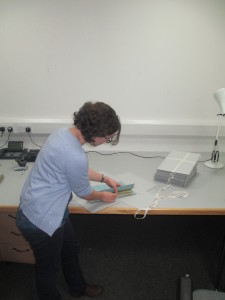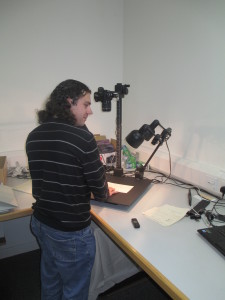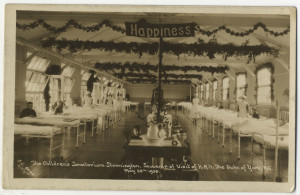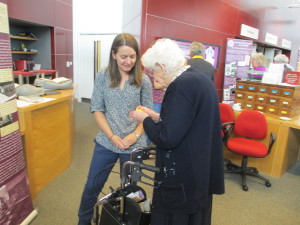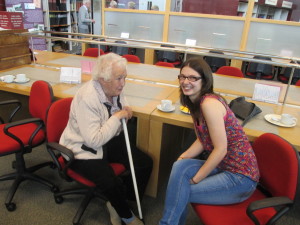In the Parish of Rothbury, owners of burgages (houses) and crofts, had for many decades, if not for several centuries, the right to graze their livestock on Rothbury Common. However, a certain landowner tried to change this in the early part of the 19th Century by attempting to enclose part of the Common for his own use.
As you can imagine, this did not go down well with the local populace and resulted in one local man, William Bolam (owner of a house, land and innkeeper of the Star Inn, all in the Parish of Rothbury) taking a civil court action against the land grabber, Adam Atkinson of nearby Lorbottle House.
Amongst the archives of Alnwick solicitors, Dickson Archer and Thorp, are bundles of papers representing the evidence gathered for the legal battle. Included in the bundles is a transcript of the court case.
The case was heard in the Nisi Prius Court (a hearing of civil cases before a judge and jury), part of the Northumberland Summer Assizes held in Newcastle upon Tyne and heard before Mr Justice Bailey on Thursday, the 16th August 1827. Representing William Bolam (the plaintiff) were barristers Brougham and Weightman and for Adam Atkinson (the defendant) were barristers Williams; Parke and Cresswell.
Mr Weightman (the junior barrister for the plaintiff) opened the proceedings by stating that ‘the plaintiff was in possession of a house and land in the Parish of Rothbury which gave him the Right of Common on the waste called Rothbury Common for his cattle, couchant and levant, namely horses, cows and sheep’. He went on to declare that ‘the defendant had put eight hundred sheep upon the said Common and had built a certain line of wall to the great injury of the Common and further prejudice of the said plaintiff’s right’.
The plaintiff’s senior barrister, Mr Brougham, then addressed the court with further detail of the circumstances – ‘Mr William Bolam, being in possession of a house, garden and a croft of land at Rothbury, had a right to graze his cattle on the Common there and had brought this action against Adam Atkinson Esq. of Lorbottle because not being content to enjoy his Right of Common like others possessed of a burgage tenement, he had thought it expedient to enjoy his portion by enclosing it and accordingly built a wall across part of the Common’. He went on to state ‘by this mode of proceeding, Mr Atkinson had added a large tract of land to his own estate, which was adjoining, without the formality of buying in the usual way’.
Mr Brougham went on to state that over a number of years, Mr Atkinson had annexed a considerable tract of land called Threap Ground, which was considered as ‘debateable ground, it may belong to Lorbottle Common or it may belong to Rothbury Common, at present we will say nothing about that but the land below the Threap Ground was never disputed, it has always been known to be Rothbury Common’. Continuing, Mr Brougham stated that Mr Atkinson then decided to annex the better land below Threap Ground, first ‘he took in 42 acres more. He then went to the Bank Head Shank and there having only 402 acres, thought he would go a little to the southward and take 420 acres more …… he gave directions for the building of this wall which was to enclose his part from the rest’. At this point, Mr Brougham informed the court that Mr Atkinson’s actions reminded him of the early settlers of North America that ‘when they want a piece of ground, they just sit themselves down on the corner of a neighbour’s estate and exercise this sort of possession for twenty years’ adding that ‘everybody knows that twenty years possession gives a right of property’. Mr Brougham carried on for several more minutes with various points of common law rights concluding with ‘…. to stop them before they get their enclosure completed. We do not seek to recover damages but to beg the question of right’.
His colleague, Mr Weightman then took over by calling a number of witnesses to be examined by giving historical evidence as to the use of the Common including the land that had been taken by Mr Atkinson. All of the witnesses for the plaintiff stated that the land in question had always been part of Rothbury Common and that those that qualified had always grazed their livestock on it.
Mr Weightman called Edward Smith, a local surveyor who stated that he had earlier been employed by Mr Atkinson to make a plan of Lorbottle Estate. Mr Smith stated that Mr Atkinson had told him ‘….. to get a person who knew the boundaries to point them out to him’.
This plan, was produced to the court and accepted by Mr Smith as the one that he had drawn up with the assistance of a Mr Balmer (now deceased). Mr Smith pointed out that the green line on the plan was drawn by Mr Balmer’s direction and excluded the Threap Ground. Continuing under oath, Mr Smith said that when he showed Mr Atkinson how far he had gone, Mr Atkinson was dissatisfied. At this, Mr Brougham said ‘Aye, aye, he was not pleased at that, he had not enough you know’. Mr Smith further stated he had to redraw the plan with guidance from Mr Atkinson himself and then with the assistance of a shepherd employed by Mr Atkinson.
After the plan was redrawn to the satisfaction of Mr Atkinson, orders were given to a Walter Johnson, a local builder, for the wall to be built.
Several more witnesses for the plaintiff were called, all giving more or less the same evidence about the historical use of the Common by those who had the ‘Right of Common’.
Finally, Mr Brougham stood up and announced ‘That’s my case, my Lord’.
The judge, Mr Justice Bailey, commented that the building of such a wall, even though it was open at each end, was an obstruction to cattle grazing on common land on the north side of the wall.
Mr Williams, the defendant’s senior barrister, immediately responded by saying that in his and his client’s opinion there was no evidence to suggest that any cattle ever grazed on the north side.
Mr Justice Bailey responded by saying that where there was a Right of Common (i.e. access to graze animals on all of the common acreage), then that right must be upheld.
Mr Williams then addressed the jury: ‘The charge as presented before them and laid was that the plaintiff was entitled to a Right of Common over a place where a wall had been erected having a house and premises which are capable of maintaining in the winter the cattle for which he claimed the right in the summer and he had to submit to them that the plaintiff had not made out to their satisfaction either that he had the right in question or that that right extended over the Common to the wall in question’. He went to question the evidence given by several of the plaintiff’s witnesses and then followed that by saying ‘There was no evidence of any Right of Common where this wall was built. The wall was erected in the presence of Mr Clint, the head umpire between the Duke of Northumberland and Mr Atkinson. If then the Duke was satisfied, it was pretty evident that everything to the north of the wall belonged to Mr Atkinson.’ He then submitted to the court ‘That the building of the wall, with the sanction and under the inspection of the Agent for the Duke, showed that the Lorbottle estate extended to the wall.’ He ended his address by saying that there was no evidence of the plaintiff (Mr Bolam) having premises which gave him the Right of Common that he claimed and that the wall was the correct and proper boundary over which the plaintiff had no right to pass and that his client (Mr Atkinson) was entitled to a verdict in his favour.
Mr Justice Bailey then summed up the evidence saying that ‘The points for the consideration of the jury would be, had the plaintiff the right to which he claimed on that Common.’ He went to say to the jury that ‘The circumstance of the Duke being satisfied respecting the boundary line was no ground that the commoners should concede a right which they previously held.’ Carrying on, he said that for the Duke to be satisfied it would be on evidence and that evidence should be produced to the court. As no such evidence was produced it was for the jury to decide that if the plaintiff had Right of Common and if the answer was yes, then they have to decide if the wall was preventing access for the plaintiff’s cattle and that the fact that the wall was open at each end does not vary the case, if there was a Right of Common then the wall was a clear obstruction of that right.
The jury then retired and after a short consultation returned with the verdict – ‘We find for the plaintiff in respect of horse grass. Damages of one shilling and we think the wall should be taken down.’
The Tyne Mercury; Northumberland and Durham and Cumberland Gazette published on the 21st August 1827 reported on the case and ended with the following:
‘The important and interesting case of Bolam v. Atkinson having been decided in favour of the plaintiff, a numerous assemblage of people, inhabitants of Rothbury and the neighbourhood, proceeded on Friday afternoon with an elegantly decorated chair to meet Mr E Wilson and the plaintiff. The former, on account of his assiduous and preserving exertions in promoting the favourable issue of the case, was placed in the chair, and carried in triumph to the house of the plaintiff (the Star Inn), amidst the shouts and acclamations of hundreds.’
Postscript
William Bolam died in October 1829 and was buried in All Saints churchyard, Rothbury on the 18th October. His Will described him as an Innkeeper of the Star Inn, Rothbury.
This blog was produced by a project volunteer, we would like to thank them for their time and research.


